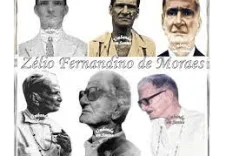The Birth and Evolution of Umbanda in Sacred Umbanda
By:
Juliana De Obaluae
On
25/06/2024Reading time:
12 min
Summary:
The Birth and Evolution of Umbanda- By Cumino-Alexandre in História da Umbanda, Ed. Madras; Translated by this blog
The new religion, the beloved child of the Orixás, Sacred Umbanda, was born discreetly, nurtured by the generous breast of Iemanjá, and is already as beautiful as Oxum. But she is as feisty as Iansã, as healing as Ossaim, as a hunter at heart as Oxóssi, as vengeful as Xangô, as charitable as Obaluaê, as firm as Ogum, as punishing as Omulu, and as comforting as Nanã. The ideal archetype of the old and loving black grandmother, always ready to smile at her grandchildren growing up, even in the senzala. But not everything happened so "naturally".

Pai Benedito de Aruanda, a wise Preto Velho in Umbanda, offers healing and guidance with a focus on humility and charity
Father Benedict of Aruanda, psychographed by Rubens Saraceni.
It is not enough to say: Umbanda was founded on November 15, 1908, on Brazilian soil. It is necessary to substantiate this statement with historical facts, sociological movements, and anthropological insights into the production of a new culture.
Umbanda is characterized by the confluence of different factors, creating a unique religious amalgam. Some saw it as a form of Africanized Kardecism, others as whitened Africanism. However, Umbanda is something new, born on Brazilian soil. It is not the religion of one ethnic group but the result of their blend, producing a meaning that is no longer explained by race but rather by its identification with the Brazilian people.
Initially characterized as religious syncretism, new studies now show Umbanda as the synthesis of the Brazilian people. It is a religion of the "Brazilian Religious Matrix."
The Birth of Umbanda
"I have come to bring Umbanda, a religion that will harmonize families and last until the end of times." – Caboclo das Sete Encruzilhadas, November 15, 1908.
The first Umbanda tents gained prominence in Rio de Janeiro at the beginning of the 1920s, spreading to other states by the 40s and 50s. During this time, significant field research by figures like Nina Rodrigues and João do Rio identified various religious and spiritual expressions, but not yet Umbanda.
The first Umbanda tent, Tenda Espírita Nossa Senhora da Piedade, was founded on November 15, 1908, by Zélio de Moraes and his spiritual mentor, Caboclo das Sete Encruzilhadas. This account, provided by Umbanda Priest Ronaldo Linares, details how Zélio's mediumistic abilities were discovered and developed, leading to the establishment of Umbanda.

Zélio Fernandino de Moraes was the founder of Umbanda, a Brazilian spiritual religion, in 1908.
Significant Events and Teachings
The magazine "Gira da Umbanda," edited by Atila Nunes Filho in 1972, highlighted Zélio de Moraes's journey and the establishment of Umbanda. The teachings of Caboclo das Sete Encruzilhadas emphasized humility, charity, and love, rejecting any form of monetary charge for spiritual work.
Fifty years of mediumistic activity saw the establishment of numerous Umbanda tents across Brazil, guided by the principles laid down by Caboclo das Sete Encruzilhadas.
Final Words from Caboclo das Sete Encruzilhadas
"Umbanda has progressed and will progress much more. There must be sincerity, love among its practicioners to prevent the vile currency from destroying the medium. We must always be on guard against the obsessors. Umbanda should always be of humility, love, and charity. That’s our flag."
There are several factors and accounts that challenge the traditional narrative of Umbanda's founding in 1908:
Pre-existing Practices: Some researchers argue that elements of what would become Umbanda were already present in various Afro-Brazilian religious practices before 1908. These practices included elements of Candomblé, Catholicism, and Kardecist Spiritism, which were syncretized in various ways across Brazil.
Lack of Immediate Recognition: Historical records and research by scholars such as Nina Rodrigues and João do Rio do not mention Umbanda explicitly during their studies in the early 20th century, suggesting that Umbanda may not have been recognized as a distinct religion immediately after 1908.
Gradual Development: The formation of Umbanda is seen by some as a gradual process that involved the blending of multiple religious traditions over several decades, rather than a single, defining moment of creation. This view posits that Umbanda evolved organically from the rich spiritual landscape of Brazil, rather than being founded by a single individual on a specific date.
Diverse Foundational Figures: Other figures besides Zélio de Moraes have been noted for their contributions to the development of Umbanda. This includes various mediums and spiritual leaders who played significant roles in shaping the practices and beliefs of Umbanda communities across Brazil.
Multiple Origins: Some scholars suggest that Umbanda did not have a singular point of origin but rather emerged from multiple regions and communities in Brazil, each contributing unique elements to the religion's development.
For further reading, consider these sources:
"Umbanda: Religion and Politics in Urban Brazil" by Diana DeG. Brown: This book explores the historical and social contexts of Umbanda, offering insights into its complex development.
"Umbanda: A New Religion" by Conrado Luciano da Silva: This book delves into the religious, cultural, and historical aspects of Umbanda, providing a comprehensive overview of its evolution.
Research by Renato Ortiz: Ortiz's work on the African and Brazilian black populations includes discussions on the emergence and recognition of Afro-Brazilian religions, offering a broader context for understanding Umbanda's origins.
>For more information about Pai Benedito de Aruanda and his role in the Umbanda religion, you can refer to various sources on Afro-Brazilian spirituality and Umbanda practices.<
Subscribe to our newsletter
Subscribe our newsletter to get weekly updates.
